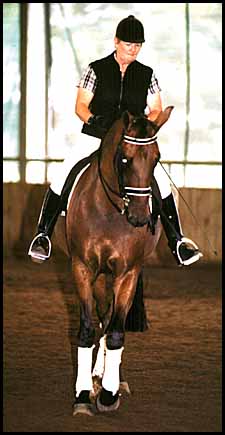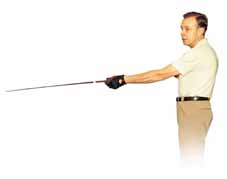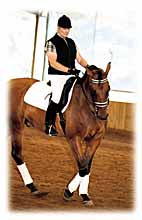Story & Photos by Roz Neave
This month our pupil is Lorraine Davey. Lorraine’s horse is Pinnacle Park Rasputin, by the imported Hanoverian Daktylus (dec.), and as Chris and I bought him as a foal at foot with his mother Fiery Pearl, I have a special interest in him.
He was the most irritating immature young horse to handle on the ground that I have ever met, not bad, just a wriggly, nippy baby. Lorraine has transformed him into an elegant and focussed dressage horse, which is a credit to her skill as a horseperson.
Lorraine was quite nervous before the lesson, ‘the horse will be OK, it’s the rider we have to worry about.’
Miguel has been working with Lorraine and Rasputin since the horse’s purchase two years ago.
The day’s session started with the Tavora signature, shoulder-in-on-the-circle (see Going to Collection Laterally, June 1998).
“We start with the simple exercise, shoulder in on the circle, always, because it makes the horse very loose, very supple, very going. We make the horse, loose, relaxed and supple. Then, little by little, we start, with the exercises, to ask for more collection.”
“We also used counter canter in the warm up to make the horse straighter, more through. The horse is much stronger now, more mature, which means we can start counter canter earlier on in the working session. We start from the beginning of the session to make the horse through, to make him be serious, not letting him cheat by putting his hindquarters to the right, and curling to the right. He’s a lot more through and steady now.”
Then on to more trot work…
“We progress to shoulder in along the wall. Then travers, renvers, increasing the degree of collection by the exercises, and so we end up going gradually from the simple to the more difficult. We develop the collection without breaking the flow, without blocking the horse, without stopping the horse’s willingness to cover the ground and go forward.”
“We started flying changes a few weeks ago. With some of the exercises we are using, the changes come through quite well.”
The first exercise was to come off the long side in a half circle to the centre line, make a few steps of canter half pass back to the long side and then for Lorraine to ask for the change.
“The half pass makes the canter more bouncy, more collected, more engaged. He tends to flatten in the flying change, loses expression of the canter and drags a bit through the change.”
The second exercise was counter canter on the circle, with Lorraine flexing Rasputin first to the inside, and then to the outside, in contra bend, several times, and then asking for a change from counter canter to true canter.
“This exercise made the horse very loose, able to jump more in the change, with more impulsion. The exercise made the canter better, and so made the change more expressive, more impulsive, more powerful.”
“The flying change depends only on the quality of the canter; if the canter is good the flying change is good. If the canter is expressive, the flying change is very expressive. If the canter is flat, without impulsion, the flying change must be like the canter.”
Last time I saw the horse work, he was progressing, but he was still a bit of a clown, what’s brought about the transformation?
“The enormous advantage of all the exercises we do, is not only that they are good gymnastic exercises, it’s also that we make so many transitions, we ask one thing, and then another thing, we make the horse attentive to the rider’s demands.”
“We make the horse attentive to the rider’s aids, because he never knows what’s going to happen, and the variety is so great: he goes from shoulder in to hindquarters in, travers, renvers, rein back medium trot. The rider is always making transitions from one exercise to another, so it’s not just a physical gymnastic for the horse, it’s also a mental gymnastic. The horse has to be always ready to obey the different things the rider asks.”
And after the session, I talked to Lorraine…
It was a lot for you to take on, a young horse like Rasputin…
“He was three when I bought him. Miguel rang me up and said, ‘would you like to come and ride this horse?’ I loved him as soon as I saw him, and rode him and bought him, just seeing him once. I had him vet checked of course, but I bought him without even seeing him again.”
“I’ve never had any doubts about the horse, sometimes I have doubts about the rider!! The physical capabilities at my age.”
Do you mind telling everyone your age?
Slight pause – “I’m fifty four, I’m a grandmother and I didn’t ride a dressage test until I was forty seven.”
Do you do anything to keep up your fitness level?
I do about ten minutes bending and stretching before I get on the horse. My level of activity goes in fits and starts. I’ve done aerobics when I’ve put on weight, but I mainly keep fit riding and working around the farm.”
“Rasputin has fifty six EFA points, and is now competing at elementary, and we’ve had wins and placings. We can go out and have a good day, but sometimes tension gets to him.”
“I want to go on competing. Sometimes we have stumbling blocks in training, but I like the horse a lot, and I’ve never had any doubts about him. I’d like to go as far as I can with him, as far as Miguel can take me.”
How do you feel when you’re working on something new, like the changes?
“I don’t find it disappointing or frustrating, we did achieve what we were aiming for. I try to focus on the good things, and just work harder on the things that still have to come together. I haven’t worked on the changes on my own that much, because I didn’t want to get it wrong. I like to get to the higher level work, it’s a buzz.”
Miguel Tavora
Miguel was born in Lisbon, Portugal, and at the age of eight commenced his equestrian studies with the famous riding master, Nuno Oliveira. He rode with Nuno until he was eighteen years old, when he went to the Military Academy where he competed extensively in eventing and showjumping.
When he was 28 years old Miguel took the cavalry instructor’s course and because he passed with over 75%, he went on to complete a Master’s Course, and was then appointed as the chief instructor of the equestrian division of the Maffra School.
By this time, Miguel was mainly competing in dressage.
In 1982, at the age of 39, Miguel migrated to Australia. Since then he has produced about twelve Grand Prix dressage horses and established himself as one of our most sought after trainers, conducting clinics all around Australia, and more recently, in the United States.
His equestrian philosophy in one sentence?
“That is very difficult in a single sentence. We need to do things correctly, we can’t compromise – classical and academic is nothing more than correct and rational. We have to think what the question is… You have to enjoy, and if you enjoy you learn, and if you learn, then you enjoy more.”



